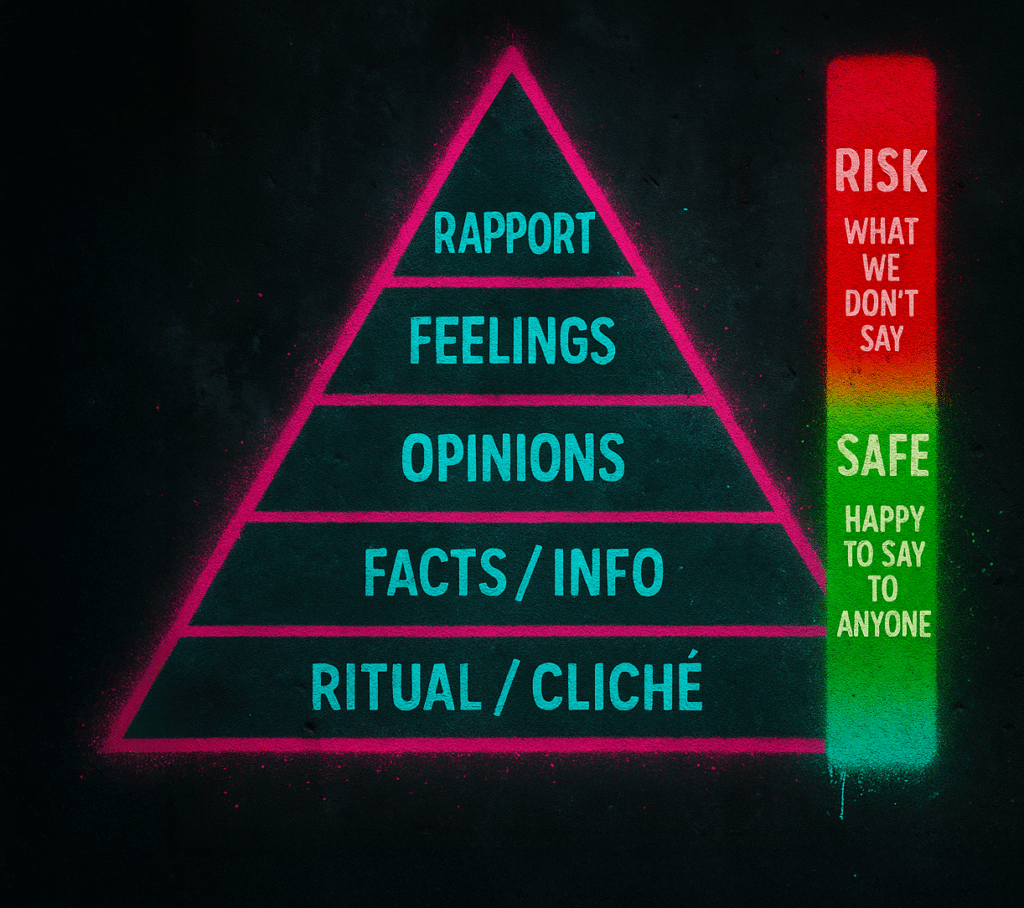Most teams believe they communicate well. But if you scratch beneath the surface, what you often find is this: lots of noise, lots of words, but very little real connection.
At Elev-8, we talk a lot about team climate – the lived experience of being in your team. And one of the strongest levers leaders have to shape that climate is the depth of communication they create. Not just the frequency, but the quality.
And if you’re leading change? This becomes even more important. Change creates uncertainty, doubt, and resistance. What people crave most is clarity, honesty, and trust – and you can only build that by moving higher up the communication pyramid.

1. Rituals and clichés – “the polite surface”
This is the safe, automatic level of interaction.
“How are you?”
“Busy!”
“Good weekend?”
It’s not meaningless – these rituals serve as social glue, ways of acknowledging each other. But if your team’s conversations never move beyond this, you’ll never build trust or performance.
During change, staying stuck here leaves people in the dark. Politeness without substance fuels rumour and corridor conversations.
2. Facts and information – “the data exchange”
Here’s where most workplace conversations sit. Sharing updates, passing on knowledge, coordinating tasks.
“The new system goes live next Monday.”
“We’re restructuring the team into three regional groups.”
Facts matter – and in change, facts are critical. People need clear, transparent information. But notice, they’re still safe. They don’t tell you what people think or feel. A team that only talks in facts might be efficient, but it won’t be resilient or innovative.
3. Opinions – “the first step into risk”
Now we start to take a chance. Sharing an opinion means opening yourself up to challenge, disagreement, even judgement.
“I don’t think this change is working.”
“We’re prioritising the wrong customers.”
This is where trust starts to be tested. Leaders who only want agreement will never hear the truth. Leaders who encourage opinion – and genuinely listen – build confidence and inclusion.
In times of change, this is essential. If people can’t share their doubts or challenge the direction, resistance goes underground. And what’s unspoken is always more dangerous than what’s said out loud.
4. Feelings – “where trust gets real”
Feelings are harder to share because they carry more risk. In many workplaces, emotion is seen as unprofessional, so people keep it hidden. But it’s often the most important signal.
“I feel frustrated we keep going round in circles.”
“I’m anxious about this change failing.”
During change, feelings are everywhere – fear, loss, excitement, hope. If leaders ignore them, they don’t go away, they just leak out in other ways: resistance, disengagement, or burnout.
When leaders show it’s safe to express feelings, the climate changes. It creates psychological safety. It makes people braver, more honest, and more connected.
5. Rapport – “the top of the pyramid”
True rapport isn’t about being best friends. It’s about reaching a level of openness where people can say what really matters, even when it’s difficult. It’s where conversations move from transactional to transformational.
This is the space of candour, of vulnerability, of deep trust. It’s where the best teams live – because only here can they face uncomfortable truths, solve real problems, and grow together.
In change, rapport is the difference between compliance and commitment. People don’t just need to understand the change – they need to believe they’re safe enough to step into it.
The confidence–trust trade-off
If you look at the pyramid, the bottom levels are safe. You can share rituals and facts with anyone. But the higher you go, the more confidence and trust are required.
That’s also where the risk lies. The danger in teams isn’t usually what’s said – it’s what’s left unsaid. Opinions never voiced. Feelings bottled up. Rapport never reached. Those silences cost performance, innovation, and engagement.
During change, those silences multiply. People tell you what they think you want to hear. They nod along. And underneath, they resist.
Leaders have a choice: keep the team in the “safe” green zone, or intentionally build the trust that lets people step into the red.
What leaders can do
To move your team up the pyramid, especially in change, try this:
- Model it first. Share your own feelings and opinions. Go beyond facts. Show vulnerability.
- Create safety. Thank people for honesty, even if you disagree. Make it clear that candour won’t be punished.
- Listen deeply. Don’t just hear the words – notice what’s not being said.
- Normalise challenge. Encourage people to voice dissenting views, and frame it as a contribution, not a threat.
- Praise progress. When someone takes the risk to move higher up the pyramid, recognise it.
At Elev-8, we often say: climate beats culture. And communication is one of the biggest drivers of climate. If you want a team that’s innovative, resilient, and high-performing, you can’t stay stuck at rituals and facts.
And if you want to lead people through change? Then creating space for opinions, feelings, and true rapport isn’t just nice to have – it’s non-negotiable.
The real magic happens when you create the conditions for true rapport.



